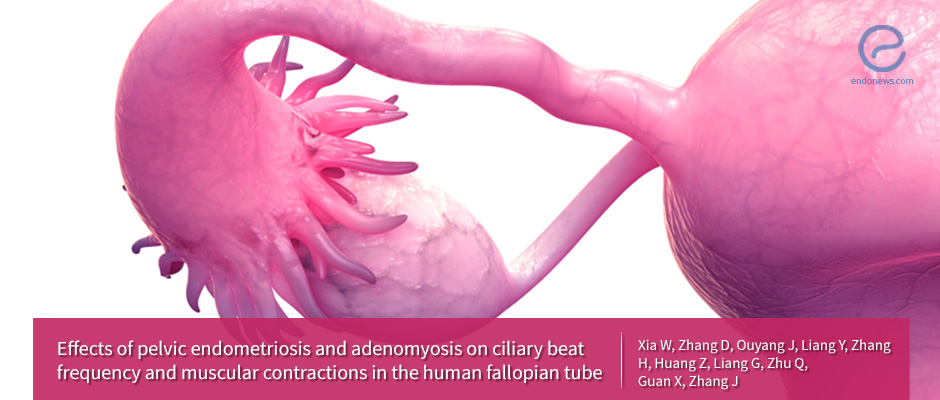Fallopian Tube Capability in Women with Pelvic Endometriosis and Adenomyosis
Jun 28, 2018
Women with the tubal form of Pelvic Endometriosis were found to adversely impacted Fallopian tube transport capabilities.
Key Points
Highlights:
- This study analyzes the Fallopian tube transport capability in women suffering from Pelvic endometriosis (EM) and adenomyosis (AM). The researchers seek to achieve the aforementioned goal using tubal smooth muscle contraction and ciliary beat frequency (CBF).
Importance:
- The authors state that there are no studies conducted that used the methods used in this study to simultaneously analyze the fallopian tubes cilia and muscle transport capacity in women with pelvic EM and AM. So, this study is novel and may shed some light on some aspect of endometriosis and infertility that was not understood before.
What’s done here?
- The participants included:
- Control group: 20 women with uterine leiomyoma
- AM group: 20 women with adenomyosis but no pelvic EM
- EM group: 35 women with pelvic EM but no AM
- This group was further divided into tubal EM and non-tubal EM groups
- The researchers collected the ampulla and isthmus of human fallopian tubes. The tubes were rinsed and certain tissue, namely the muscular and epithelial tissues, were dissected.
- The next part of the experiment is Hematoxylin and eosin (H&E) staining and immunohistochemistry.
- The researchers evaluated and classified cases of tubal endometriosis.
- Imaging and analysis were used to measure CBF.
- Microscopy was also used to count ciliated and total cells.
- The researchers also analyzed the contraction of the muscle strips.
- The data was subject to statistical analysis.
Key results:
- The EM case had lower CBFs of the ampulla. Additionally, tubal EM cases also had lower CBFs of ampulla and isthmus.
- Participants with EM had lower percentages of ciliated cells in the ampulla and isthmus segment. Additionally, the tubal EM cases also had lower percentages than the non-tubal EM and control cases.
- EM cases were found to have lower amplitude-to-weight ratios with respect to longitudinal muscular contractility. Tubal EM participants had lower ratios than the control and non-tubal EM groups.
- EM participants had lower contraction frequencies in both muscle types, namely longitudinal and circular. The tubal EM cases also had lower values for these contraction frequencies when compared to the control and non-tubal EM subgroups.
Limitations of the study:
- The authors listed the following as limitations of the study:
- The researchers were not able to a salpingectomy on patients with mild endometriosis because these patients have surgeries to get pregnant.
- Stage I and II EM patients were not included, So the researchers did not ascertain if mild EM has any effect on fallopian tube function.
- The researchers did not assess other tubal segments, such as the interstitial and fimbria.
- The researchers did not use transmission electron microscopy to observe tubal ultrastructure.
- The researchers should have used animal experiments to assess transportation function in vivo.
Lay Summary
Xia et al. recently published a paper titled “Effects of pelvic endometriosis and adenomyosis on the ciliary beat frequency and muscular contractions in the human fallopian tube” in Reproductive Biology and Endocrinology. This research group primarily from Shanghai Jiaotong University conducted a study that assessed the fallopian tube transport capacity in women who suffer from Pelvic endometriosis (EM) and adenomyosis (AM). Transport capability of the Fallopian tube was to be measured using ciliary beat frequency (CBF) and tubal smooth muscle contraction.
The study had 3 different groups of participants. The first was a control group made up of women with uterine leiomyoma. The second was the AM group made up of women with adenomyosis, but these women did not have pelvic EM. The third was an EM group made up of women with pelvic EM without AM. The EM group was further divided into women with tubal EM and non-tubal EM. The researchers collected the ampulla and isthmus of human fallopian tubes from each of the participants. The tissue underwent Hematoxylin and eosin (H&E) staining and immunohistochemistry. The tubal endometriosis diagnosis was confirmed and then the different cases were evaluated and classified. The researchers also used microscopy to measure CBF and ciliated cells percentage. They also analyzed muscle strip contraction. The data from the experimental process was subject to statistical analysis.
The researchers found that the CBFs of the ampulla was lower for patients in the EM group. The tubal EM cases were found to have lower CBFs in the ampulla and isthmus than the participants in the control and non-tubal EM groups. The percentage of ciliated cells in the ampulla and isthmus, the amplitude-to-weight ratios of longitudinal muscular contractility, and the contraction frequencies for longitudinal and circular muscles were found to be lower in EM cases when compared to control cases and AM cases. Similarly, tubal EM cases had lower values for all of the measurements mentioned in the last sentence when compared to control and non-tubal EM groups.
The researchers conclude that patients with tubal EM have severely impacted fallopian tube transport capabilities. On the other hand, the tubal function in patients with non-tubal EM and AM is not impacted due to the disease.
Research Source: https://www.ncbi.nlm.nih.gov/pubmed/29753325
pelvic endometriosis adenomyosis fallopian tube ciliary beat frequency muscular contractions

